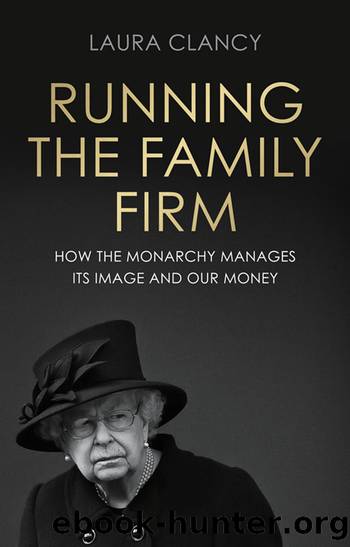Running the Family Firm: How the Monarchy Manages Its Image and Our Money by Laura Clancy

Author:Laura Clancy [Clancy, Laura]
Language: eng
Format: epub
Tags: Social Science, Sociology, General, Media Studies, Social Classes & Economic Disparity, Anthropology, Cultural & Social
ISBN: 9781526149329
Google: xOFDEAAAQBAJ
Publisher: ManchesterUP
Published: 2021-09-28T20:48:19+00:00
âThe Kate effectâ
In the 1910s, the Soviet film-maker Lev Kuleshov demonstrated what he called âthe Kuleshov effectâ: a film-editing phenomenon where viewers receive meaning from the sequential editing of shots rather than each shot on its own. Kuleshov created a short film featuring the expressionless face of the actor Ivan Mosjoukine, which were interspersed with various other, entirely disparate, shots (for example, a girl in a coffin, a bowl of soup). He found that the cumulative effect meant that audiences believed that Mosjoukine's expression changed each time he appeared, depending on which object he appeared to be âlooking atâ (grief or hunger, respectively). The experiment demonstrates that cinema's meaning âexists in the mind of the spectator rather than the celluloid itselfâ, because Mosjoukine's face was the expressionless receptacle on to which audiences projected meaning.41
I argue here for the relevance of what I call âthe Kate effectâ, whereby the meaning of Kate is constructed by virtue of the clothing â the costume â she wears in particular representations, and the cumulative effect of these. Her unchanging smiling face (the happy housewife) in all representations can be read in conjunction with Mosjoukine's expressionless one: it relies on the context of Kate's surroundings to give it meaning. Unlike Meghan Markle, who was an established celebrity upon joining the Firm, Kate has been made by the monarchy. Very little is known about Kate and she gives few public speeches. The few times her voice has been heard it is directly connected to the Firm, tied to either heterosexual family life (an interview for her and William's engagement), feminised charitable interests (children's and mother's mental health issues, art gallery patronages) or rare feminised television appearances (A Berry Royal Christmas, featuring Kate baking with the British chef Mary Berry).42 Like Mosjoukine's face, in film theory terms Kate is a non-specific sign, with meaning projected on to her depending on her costumes. Art historians have used clothing to unearth the details and significance of portraiture, and Hilary Mantel drew on this work to describe Kate as âa jointed doll in which certain rags are hung ⦠she was a shop-window mannequin ⦠entirely defined by what she woreâ.43 Kate's image is multiple as she moves between costumes to present different personas â the housewife, the celebrity, the middle-Englander and the aristocrat.
In July 2015, the newborn Princess Charlotte's christening was held at the Sandringham Estate in Norfolk. Here, the Cambridge family displayed traditional 1950s styling, drawing on royal moments past (Figure 6.2). George was dressed in an embroidered smock top with formal red shorts and traditional buckle shoes, an almost exact copy of an outfit his father had worn as a toddler in 1984.44 Charlotte was wrapped in the traditional royal christening gown, and put in an antique pram used at Prince Charles's christening in 1948 â not a pushchair designed to fit in a car for the âmum on the goâ, but a retro carriage for the camera.45 Kate wore a demure white coatdress with fascinator and low-heeled court shoes.
Download
This site does not store any files on its server. We only index and link to content provided by other sites. Please contact the content providers to delete copyright contents if any and email us, we'll remove relevant links or contents immediately.
Buying Reality: Political Ads, Money, and Local Television News by Danilo Yanich(421)
Handbook of Research on Deception, Fake News, and Misinformation Online by Chiluwa Innocent(189)
Mapping the Magazine by Tim Holmes(155)
Analysing Newspapers : An Approach From Critical Discourse Analysis by John E. Richardson(149)
Racism in American Popular Media: From Aunt Jemima to the Frito Bandito by Brian D. Behnken & Gregory D. Smithers(143)
Global Mobile Media by Gerard Goggin(139)
Media Literacy by W. James Potter;(136)
English for Diplomatic Purposes by Patricia Friedrich(132)
Transgression 2.0 by Ted Gournelos David J. Gunkel(128)
The Playful Citizen : Civic Engagement in a Mediatized Culture by René Glas; Sybille Lammes; Michiel de Lange; Joost Raessens; Imar de Vries(113)
Teaching to Transgress: Education as the Practice of Freedom by Hooks Bell(107)
Running the Family Firm: How the Monarchy Manages Its Image and Our Money by Laura Clancy(106)
Media and The City : Urbanism, Technology and Communication by Simone Tosoni; Matteo Tarantino; Chiara Giaccardi(100)
The Digital Reporter's Notebook by Mark Blaine(98)
Powermatics by Marike Finlay - de Monchy(94)
Hacking Gender and Technology in Journalism by Sara De Vuyst(93)
Transnational Television Remakes by Claire Perkins Constantine Verevis(90)
Mediating Post-Socialist Femininities by Nadia Kaneva(88)
Cultural Studies Vol 18 1 Jan 2 by Various Authors(88)
